I grew up in Panama, where there is plenty of yuca and plantain to go around, but I never heard of fufu, the West African staple made of starchy vegetables, until I was older. When I came across fufu, I noticed it resembled the Puerto Rican dish Mofongo, which is a mashed plantain or yuca served with savory stew. Fufu reminded me so much of the yuca and plantain dishes I used to eat growing up in Panama. So to honor this secondhand nostalgia and discovery of a new dish, I'm sharing this African fufu recipe that will pair great with African Pepper Chicken soup.
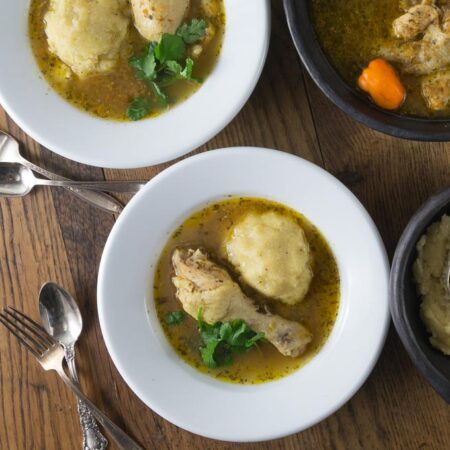
Jump to:
Fufu Background
Fufu is an essential part of West and Central African diets. Very simply, fufu is a doughy, starchy ball that you use to dip into your main meal, such as a meat or vegetable stew. Fufu is not a meal in and of itself, rather it's an addition or a side dish. You can make it with any kind of starchy vegetable, like a cassava, plantain, or yam. Although you can use any kind of starchy vegetables, the preparation doesn't change. Fufu is always boiled, then mashed using a mortar and pestle until it's smooth and in the shape of a ball. You never want to fry it. It's a pretty versatile and easy recipe.
Since it is eaten across Africa and the Caribbean, there isn't just one way to make fufu. The textures and ingredients vary in each country. For example, in Nigeria, Ghana, and Cuba, it's made with cassava and green plantains. In Malawi and Zambia, it's made with cornmeal. For this fufu recipe, we'll be making it with either yuca or fufu flour. You can typically find fufu flour in Walmart or other specialty African/Latin American food stores. If you don't have access, you can click on that link to purchase it from Amazon.
History of Fufu
Fufu came to Africa by way of Portuguese traders in the 16th century. They brought cassava, the starchy vegetable, which originally came from their expeditions in Brazil. Cassava is used in some fufu recipes, like in the traditional Ghanian recipe. As I mentioned earlier, there are different ways to make fufu in Africa, and each country has its own name for the starchy vegetable side. In Côte d'Ivoire, it's called "foutou". In Nigeria, it's referred to as eba. All of these different names relate to the same idea behind the dish: a starchy vegetable, mixed and smashed with hot water.
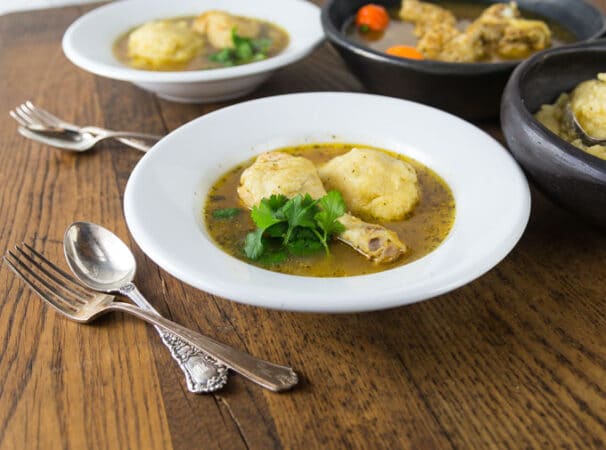
In the 1500s, Africans brought fufu to the Caribbean. While the Caribbean version is a plantain fufu, the end result tends to be more dense rather than gelatinous. When I ate mofongo for the first time, I realized it had much more flavor elements than African fufu. That's because mofongo recipes call for frying the plantains and tend to add more ingredients like chicharrones (pork rinds) and lots of garlic, keeping close to Creole-style cooking.
How to make traditional fufu
The classic way to make fufu is simple. First, you need to choose which starchy vegetable you want to use. We'll stick with yuca. All you need to do is peel the cassava and cut it into chunks, and throw it in some a large pot of boiling water. After a few minutes, you'll remove them from heat and strain them. Once they've cooled, you mash up the softened cassava with a few added ingredients, and you're good to go. Seriously, fufu is so easy to make. We will use another variation with plantain in our recipe.
How do you eat fufu?
As I mentioned earlier, fufu is eaten as a sort of side dish or replacement for rice and bread. First, you'll need a stew or soup to eat it with. For our purposes, you'll pair your fufu with this African Pepper Soup recipe below and use your hands to eat it.
Eating fufu is simple. Once you have your ball of fufu boiled and mashed, you're ready to go. You'll rip off about a quarter-size piece from the whole ball. Then, you'll flatten it using your hands. Typically, you'd just use one hand to flatten out your fufu, but there is a bit of a learning curve, so use both hands if needed! Once it's flat, make a little dent in the middle so the fufu is able to hold your soup or stew. Dip it into your soup or stew, and take a bite. This starchy food is the perfect accompaniment for a fiery, spicy dishes, since fufu itself doesn't have a very strong flavor. They balance each other out perfectly.
To be as traditional as possible, I must make some special and interesting notes about eating fufu. In some countries like Ghana, eating it with your left hand is considered very disrespectful. In many African countries, your left hand is designated for cleaning yourself when you use the toilet, and your right hand is used for eating. Those rules don't apply in the U.S., but be sure to eat your fufu (and any food for that matter) with clean hands. To ensure that, Africans always have two bowls of clean water on the table to ensure that your hands are clean enough to eat before, and for you to clean them after. You must remember that in many African countries, they use their hands to eat, which is why they place such an emphasis on clean hands.
African Pepper Chicken Soup
We're pairing our fufu recipe with this African pepper soup or Nigerian chicken pepper soup that is commonly eaten by West Africans in countries like Nigeria and Cameroon. It is a savory light soup or stew with pepper as the forefront flavor. It's fairly easy to throw together and you can use any kind of meat, from lamb to chicken. Or, to keep it vegetarian, you can add chickpeas or lentils instead. This one of the most popular African soups or stews served across West Africa and is both an everyday soup and one that is served at the end of a party. The spicy pepper is recognized as a healing tool for illness and ailments, so it is a prized dish by many Africans.
Notes on ingredients
The soup features some ingredients you might not have used before such as Scotch bonnet, Njansa, and Maggi.
Scotch bonnet is a kind of hot pepper that is extremely common in West African cooking. It will surely add a kick to our African pepper soup, with a Scoville score of 100,000 to 350,000 Scoville units. I added a substitution for scotch bonnet in case there are none at your grocery store, which is its close cousin, the habanero pepper. Scotch bonnets are used all over West Africa as well as throughout the Caribbean in countries like Guadeloupe, Haiti, and Jamaica.
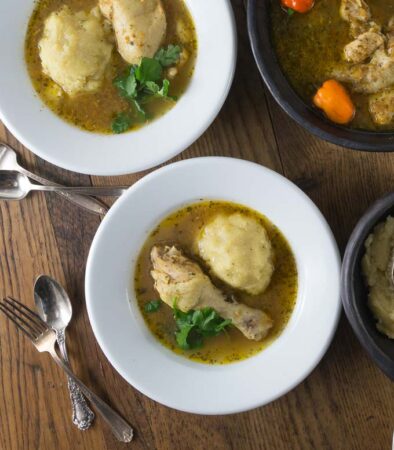
Njansa is a nutty and aromatic Cameroonian spice that comes from the Ricinodendron plant. The kernels are harvested from the tree, which add not only spice and flavor but additional thickness to soups and stews. It's optional because it is not commonly used in the U.S., but if you can get your hands on some njansa, I highly recommend adding it.
Finally, we have Maggi. It's a sauce that comes from the Italian-born Switzerland-living Julian Maggi, who eventually founded the company Maggi in Germany. He wanted to make delicious food accessible to working-class families, so he created Maggi, the umami flavor bomb and modern-day African cuisine staple. Maggi has been in Africa since the 1950s, and is even used in many Asian countries too since it tastes just like soy sauce. Its impact on working-class families was huge, and its cultural reach is even bigger. You can find it in many countries, from Switzerland to Vietnam to Ghana. You can purchase Maggi in sauce or bouillon cube form.
Be mindful that the amount of pepper you put in will obviously influence how spicy it is. If you're sensitive to spice, stick to one Scotch bonnet. If you can't get enough spice, use all three. Like many recipes featured on the blog, this African soup varies depending on which country you live in or how your family prepared it growing up. Serve this African pepper soup for a dinner party or on a rainy day when you need to feel a little extra cozy.
Step by step photos:
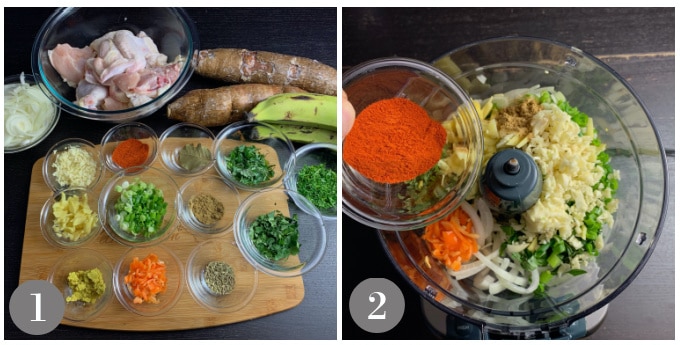
- Step 1: Gather all your ingredients and have then ready to go. I like to chop, measure and place them in prep bowls to help keep everything organized.
- Step 2: Place the onion, garlic, bouillon, paprika, cilantro, njansa, parsley, basil, habanero and green onion in a food processor. Grind into a puree.
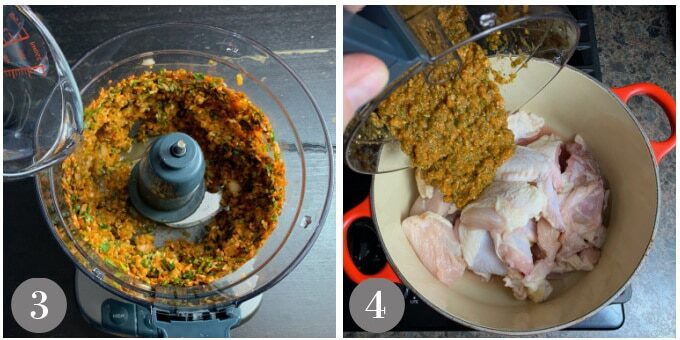
- Step 3: Add a little water to get it flowing if needed.
- Step 4: Add the chicken pieces to a large soup pot or Dutch oven then pour in the pepper paste.
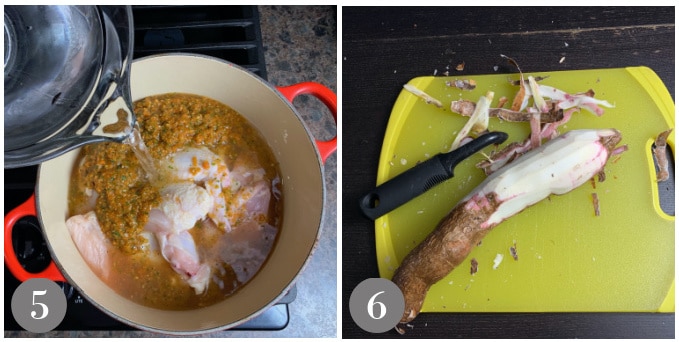
- Step 5: Add the water to the pot. Bring to a boil then simmer on low heat until the chicken is tender.
- Step 6: Peel the yuca with a potato peeler to remove the outer layer down to the white inner part.

- Step 7: Cut into pieces and remove the inner fibrous strands. Cut into 2 inch cubes.
- Step 8: Peel the plantain by taking a small sharp knife to split the peel and pry with your thumb. Cut into 2 inch cubes.
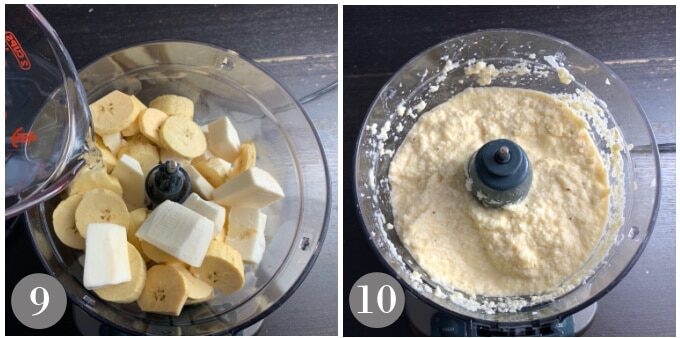
- Step 9: Place all the cubes into a blender or food processor, add 1.5 cups to 2 cups of water and blend into a fine purée or paste. 2 cups of water works better if you want it softer.
- Step 10: The mixture should form a smooth paste.
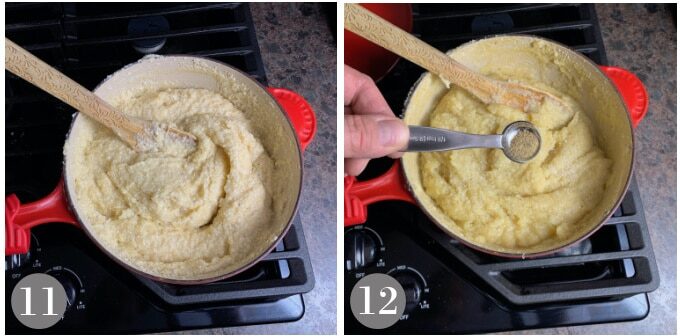
- Step 11: Heat the paste in a saucepan over medium heat. Stir continuously with a wooden spoon or spatula for 8 to 10 minutes.
- Step 12: Keep stirring to remove any lumps during the cooking process. The paste will turn more yellow as it cooks.
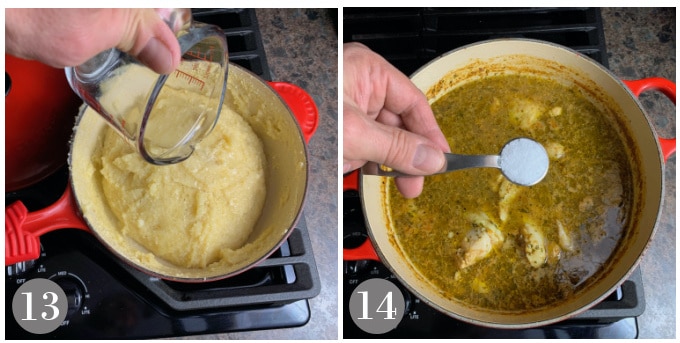
- Step 13: Add ¼ cup water, reduce the heat to low. Cover and cook for another 8-10 minutes.
- Step 14: Add salt to taste to the soup.
Frequently Asked Questions
You can store the soup and fufu in refrigerator for up to 3 days in an airtight container.
Yes, you must completely cool the soup before freezing. Store in airtight containers for up to one month. For single servings, freeze portions in a muffin tin and pop out the frozen rounds and store in freezer bags.
I would not freeze the fufu. When it thaws out it will have an unpleasant texture.
Other Popular Soups from Around the World
- Avgolemono: This is a rich creamy chicken soup from Greece with a lemony flavor.
- Middle Eastern Lentil Soup: If you have been to a Middle Eastern restaurant this simple but flavor packed soup is one make at home for sure.
- Harira is a chickpea and lentil soup with a tomato base from Morocco.
- Thai coconut chicken soup has a nice balance of sweet and savory flavors.
- Irish potato soup is like eating a creamy baked potato with butter, salt and pepper. So delicious and simple.
📖 Recipe
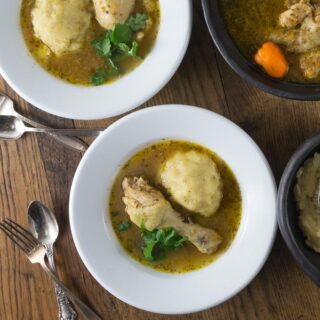
African Pepper Chicken Soup with Fufu
Ingredients
- 1 chicken entire roaster, 3-4 lbs, cut into pieces
- 1 bay leave
- 8 cups water
Pepper Paste for Soup
- 1 onion medium, sliced
- 5 cloves garlic
- 1 tablespoon chicken bouillon
- 1 tablespoon paprika
- 1 tablespoon cilantro chopped
- ¼ cup njansa optional
- 1 tablespoon parsley chopped
- 1 tablespoon basil chopped
- 2 habanero peppers cored and seed
- 2 green onions white and green parts chopped
Fufu
- 2 plantains green or unripe
- 16 oz cassava aka: yuca
- 1 teaspoon salt
- ½ teaspoon white pepper
- 2 cups water (1.5 cups for firmer fufu)
Instructions
- Cut the chicken into pieces and discard the backbone.
- Place the onion, garlic, bouillon, paprika, cilantro, njansa, parsley, basil, habanero and green onion in a food processor. Grind into a puree. Add a little water to get it flowing if needed.
- Add the chicken pieces to a large soup pot or Dutch oven then add the water and pepper paste.
- Bring to a boil then simmer until the chicken is tender. Add salt to taste before serving.
Prepare the fufu:
- Peel the yuca with a potato peeler to remove the outer layer down to the white inner part. Cut into pieces and remove the inner fibrous strands. Cut into 2 inch cubes.
- Peel the plantain by taking a small sharp knife to split the peel and pry with your thumb. Cut into 2 inch cubes.
- Place all the cubes into a blender or food processor, add 1.5 cups to 2 cups of water and blend into a fine purée or paste. 2 cups of water works better if you want it softer.
- Heat the paste in a saucepan over medium heat. Stir continuously with a wooden spoon or spatula for 8 to 10 minutes. Keep stirring to remove any lumps. The paste will turn more yellow as it cooks.
- Add ¼ cup water, reduce the heat to low. Cover and cook for another 8-10 minutes.




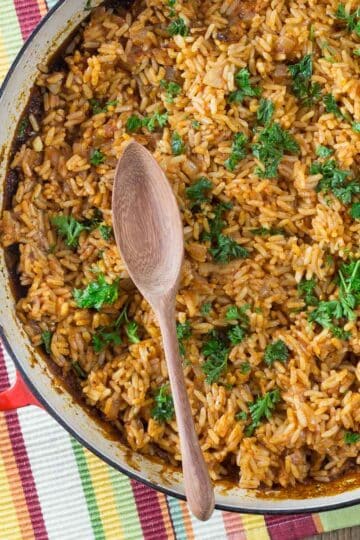
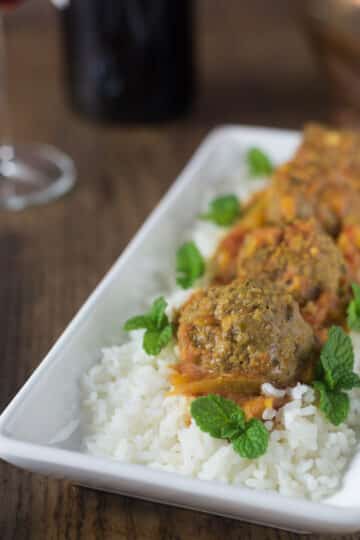
Leave a Reply